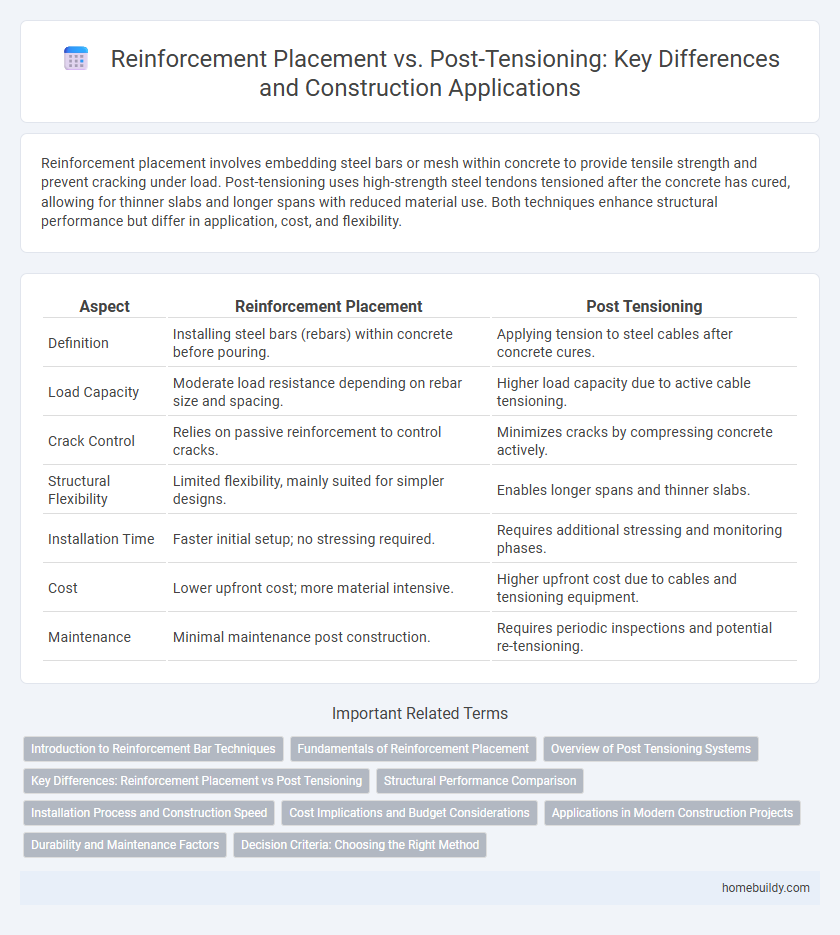Reinforcement placement involves embedding steel bars or mesh within concrete to provide tensile strength and prevent cracking under load. Post-tensioning uses high-strength steel tendons tensioned after the concrete has cured, allowing for thinner slabs and longer spans with reduced material use. Both techniques enhance structural performance but differ in application, cost, and flexibility.
Table of Comparison
| Aspect | Reinforcement Placement | Post Tensioning |
|---|---|---|
| Definition | Installing steel bars (rebars) within concrete before pouring. | Applying tension to steel cables after concrete cures. |
| Load Capacity | Moderate load resistance depending on rebar size and spacing. | Higher load capacity due to active cable tensioning. |
| Crack Control | Relies on passive reinforcement to control cracks. | Minimizes cracks by compressing concrete actively. |
| Structural Flexibility | Limited flexibility, mainly suited for simpler designs. | Enables longer spans and thinner slabs. |
| Installation Time | Faster initial setup; no stressing required. | Requires additional stressing and monitoring phases. |
| Cost | Lower upfront cost; more material intensive. | Higher upfront cost due to cables and tensioning equipment. |
| Maintenance | Minimal maintenance post construction. | Requires periodic inspections and potential re-tensioning. |
Introduction to Reinforcement Bar Techniques
Reinforcement placement involves embedding steel bars within concrete to enhance tensile strength, providing a traditional and reliable method for structural integrity. Post-tensioning uses high-strength steel tendons tensioned after concrete curing, allowing for thinner slabs and longer spans with reduced cracking. Understanding these reinforcement bar techniques is essential for optimizing load-bearing capacity while addressing design flexibility and construction efficiency.
Fundamentals of Reinforcement Placement
Reinforcement placement involves strategically positioning steel bars within concrete to resist tension and enhance structural integrity according to design specifications. Proper spacing, alignment, and anchorage of reinforcement bars ensure efficient load transfer and prevent concrete cracking under stress. Unlike post-tensioning, which applies tension forces after concrete curing, reinforcement placement focuses on embedding passive steel elements to improve tensile strength from the outset.
Overview of Post Tensioning Systems
Post tensioning systems use high-strength steel tendons tensioned after concrete placement to enhance structural capacity and control cracking, offering improved load distribution compared to traditional reinforcement bar placement. These systems reduce concrete section sizes and increase design flexibility, making them ideal for long spans and slab applications. The key components include ducts, tendons, anchorage devices, and stressing jacks, which work together to apply and maintain the tension in the concrete structure.
Key Differences: Reinforcement Placement vs Post Tensioning
Reinforcement placement involves positioning steel bars within concrete to enhance tensile strength, commonly used in traditional reinforced concrete structures. Post-tensioning uses high-strength steel tendons tensioned after concrete sets, allowing for thinner slabs and longer spans with reduced cracking. Key differences include timing of tension application, structural flexibility, and load distribution efficiency, making post-tensioning ideal for advanced engineering projects requiring optimized material performance.
Structural Performance Comparison
Reinforcement placement ensures uniform load distribution and crack control, enhancing structural integrity through fixed tensile resistance. Post-tensioning applies controlled compressive forces that counteract tensile stresses, significantly increasing load capacity and reducing deflections. Comparing structural performance, post-tensioned elements exhibit superior durability and serviceability, particularly in long-span applications, while traditional reinforcement placement offers straightforward installation and effective performance in standard concrete structures.
Installation Process and Construction Speed
Reinforcement placement involves positioning steel bars within concrete forms before pouring, ensuring structural strength by maintaining specific cover and spacing, which can be labor-intensive and time-consuming. Post-tensioning accelerates construction by tensioning steel tendons after concrete curing, reducing the volume of steel required and minimizing formwork time. This method enhances installation speed significantly while improving load-bearing capacity and reducing slab thickness compared to traditional reinforcement placement.
Cost Implications and Budget Considerations
Reinforcement placement typically incurs lower initial material costs compared to post-tensioning, but labor expenses can be higher due to complex positioning and tying of bars. Post-tensioning requires specialized equipment and skilled labor, significantly increasing upfront costs, yet it offers savings in structural thickness and material volume, potentially reducing overall budget allocation. Evaluating project-specific factors such as span length, load requirements, and long-term maintenance can influence the cost-effectiveness between traditional reinforcement placement and post-tensioning methods.
Applications in Modern Construction Projects
Reinforcement placement is essential in concrete structures to enhance tensile strength and control cracking, commonly applied in beams, slabs, and columns for residential and commercial buildings. Post tensioning, involving tensioning steel tendons after concrete curing, allows for longer spans, reduced structural thickness, and improved load distribution, making it ideal for bridges, parking garages, and high-rise buildings. Both techniques optimize structural performance, with reinforcement placement favored for conventional load-bearing frameworks and post tensioning preferred in projects demanding higher strength-to-weight ratios and durability.
Durability and Maintenance Factors
Reinforcement placement ensures effective load distribution and crack control, enhancing concrete durability by preventing corrosion through proper cover depth and spacing. Post-tensioning introduces compressive stresses that reduce tensile forces, minimizing crack width and improving long-term structural integrity. Maintenance requirements for post-tensioned systems include regular inspection of tendon protection and grouting, whereas conventional reinforcement demands vigilant monitoring for corrosion and concrete spalling.
Decision Criteria: Choosing the Right Method
Reinforcement placement involves embedding steel bars directly into concrete to enhance tensile strength and is ideal for standard load conditions and simpler structural designs. Post-tensioning applies tension to steel tendons after concrete curing, offering superior control over stress distribution and is preferred for longer spans and higher load requirements. Selecting the right method depends on factors such as structural complexity, load demands, construction speed, and budget constraints.
Reinforcement Placement vs Post Tensioning Infographic

 homebuildy.com
homebuildy.com